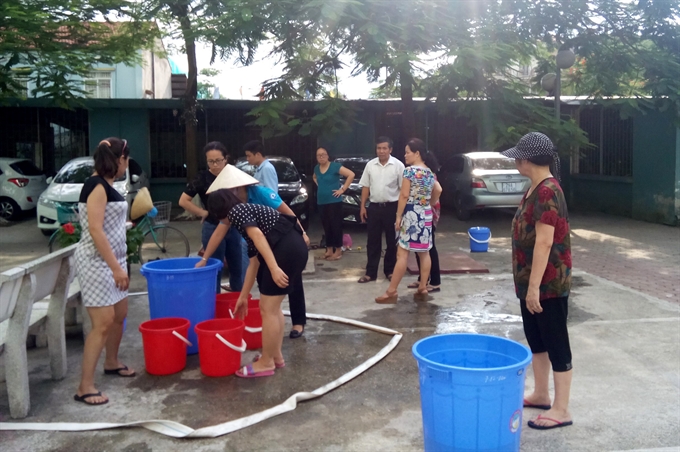|
Tap-water shortage in Hanoi
Thousands of Hanoians in Hai Ba Trung and
Hoang Mai districts still suffer from a lack of tap water.

In Hai Ba Trung District’s Bach Mai Street and Tu Do
Alley, water pumps were often broken. During torrential rains, residents even
stored rainwater for daily use, reported Tin tức newspaper.
A resident in Bach Mai Street said although staff from
the Hanoi Water Co Ltd’s Hai Ba Trung Branch came to fix the pumps, water
could only be pumped in the daytime. At night, the water supplier failed to
meet demand.
Phung Ngoc Minh, director of Hanoi Water Co Ltd’s Hai
Ba Trung Branch, said that since Cho Mo Plaza, located in Bach Mai Street,
opened in 2014, the demand for tap water in the area had increased.
This resulted in tap-water shortages on Bach Mai Street
and Tu Do Alley.
To overcome the situation, in the short term, the
branch would provide water on even hours and on odd hours alternatively for
each area, Minh said.
The situation is the same in Dai Kim urban area in
Hoang Mai District.
A representative of the urban area’s Management And
Operation Company said the demand for tap water in the urban area was up to
1,900 cubic metres daily, however, the maximum volume of water that the
company could buy from the Viwaco Joint Stock Company was 1,500 cubic
metres daily.
Second pipeline construction suspended
While residents have suffered the lack of tap water,
the plan to construct a second pipeline, carrying water from the Da River
Water Plant in the northern province of Hoa Binh to Hanoi, which began
construction last October, has been suspended.
The plan was halted because of public concern over
China’s Xinxing Corporation winning the bid to supply materials for the
pipeline.
Nguyen Van Ton, director of Vinaconex Water Supply
Joint Stock Company said the plan was suspended as the company was awaiting
the final decision from authorised agencies.
In March, the plan was postponed after Deputy Prime
Minister Nguyen Xuan Phuc instructed the city administration to review the
project.
The first pipeline, bringing tap water from the Da
River Water Plant in the northern province of Hoa Binh to Hanoi, broke 18
times since it began operations in late 2008.
This was partly to blame for the water shortages, a
source told to Tin tức newspaper.
92% of HCM City households have access to clean
water
In HCM City, nearly 1.8 million, or 92 per cent, of
households in HCM City have access to clean water, compared to 88 per cent in
December last year, according to the city’s Department of Transport.
About 150,000 households, mostly in District 12, Cu
Chi, Binh Chanh and Hoc Mon districts, do not have access to clean water.
The city’s districts have made efforts to provide clean
water for all households, but the process has been slow because of problems
related to equipment that must be installed in each household in rural
districts. These homes are located far from tap water pipes.
The equipment, which cleans and treats tap water, is
expensive, about VNĐ70 million (US$3,100). In addition, many companies have
been reluctant to bid because of the city’s quality standards for equipment.
In Binh Chanh and Cu Chi districts, for instance, 496
households have not received the equipment as scheduled.
At a meeting held last Thursday (Aug 25), deputy
chairman of the city’s People’s Committee, Le Van Khoa, told the Department
of Finance to work with agencies to create favourable conditions for districts
to complete clean-water supply targets this year.
The city’s People’s Committee has also asked Binh Tan
District and District 12 to fulfill their clean-water supply goals by the end
of October, while Cu Chi, Hoc Mon and Binh Chanh districts should complete
their targets by the end of November.
To meet the goal of providing clean water to 100 per
cent of households by the year-end, the city is speeding up construction of
water-supply works in Binh Chanh, Hoc Mon and Cu Chi districts.
By the year-end, the city aims to install 1,282 km of
water pipes and 128 general water metres, upgrade 21 water supply stations,
and install 433 water tanks and 1,193 water-cleaning devices at households in
outlying districts.
VNS
|
Chủ Nhật, 4 tháng 9, 2016
Đăng ký:
Đăng Nhận xét (Atom)
Không có nhận xét nào:
Đăng nhận xét